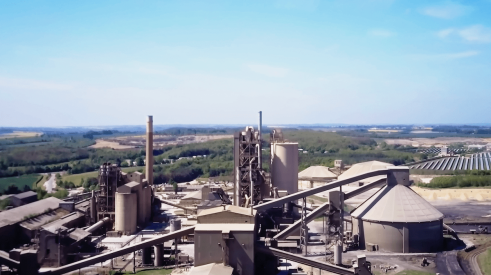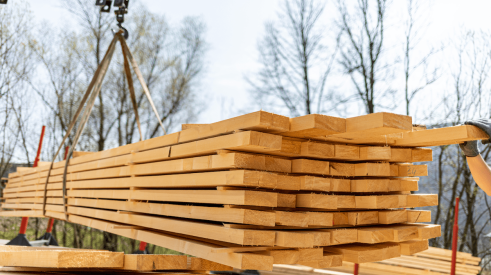Can’t find enough material to build your houses, or are you paying much more today than you did last week? Either way, building materials shortages and price increases are cutting into builder profits around the country.
| A mild winter meant more construction activity than expected, which put a strain on suppliers and in turn caused price increases. |
"I spoke with one builder who has 32 houses waiting for drywall," says Barry Rutenberg, chairman of the National Association of Home Builders (NAHB) Building Materials Task Force and president of Barry Rutenberg Homes of Jacksonville, Fla. "As for myself, I’ve had at least two 10% price increases in drywall in the last several weeks."
Rick Baumgarten, president of Lee Lumber and Building Materials in Chicago and treasurer of the Washington, D.C.-based National Lumber and Building Materials Dealers Association (NLBMDA), has been keeping an eye on the lumber and panel situation for several months.
"There is a bit of a supply problem with dimensional lumber, but the substantial price increases are of more concern," says Baumgarten. He points out that prices for engineered lumber products, specifically oriented strand board (OSB), are currently more volatile than stick lumber.
"These materials are usually bought on contract and then manufactured. That creates an artificial supply/demand situation," Baumgarten says. "Locking in a load of OSB doesn’t even protect us from price increases, because those contracts don’t feature fixed prices."
Steve Spinell, vice president of Edward R. James Homes in Glenview, Ill., says that he has been fortunate with drywall and lumber because of the company’s long-standing relationships with contractors and suppliers, but insulation and brick shortages have affected his business. "Insulation was more of a problem earlier in the year, but we communicated to the manufacturer that there was a problem and they seem to be taking care of it," says Spinell. "Brick is definitely an issue for us right now. We have a six-month lead time on our bigger projects as opposed to the usual three months."
Problem Is Hard To Measure
Exactly how widespread and serious this material shortage is remains to be seen. There is no hard and fast measurement technique, so most of the evidence is anecdotal. While economic indicators such as price indices and price components indicate shortages, they do not reflect the same severity that builders are expressing.
"Builders are saying the problems are much worse than we are reporting," says Rutenberg. "We’re trying to get a handle on it."
The effort to discern the extent of these problems has led the NAHB to conduct builder surveys. The March 1999 survey showed that 60% of respondents faced a shortage of drywall, compared to 16% in mid-1998. All areas of the country reported shortages, but the most serious problems were in the South. The same survey reported that over 80% of respondents experienced price increases from January to March. The average price increase was 10%.
Lumber consumption in the U.S. set new records in 1998, with 52.4 billion board feet of lumber and 35.2 billion square feet of structural panels used. Price surges reflect the fact that consumption is outpacing production. The yearly framing lumber composite price dropped in 1998, and while this year may not reach the highs of 1994, preliminary figures show that the composite price will be significantly higher than last year.
"We’re not having a significant supply problem with lumber," says Pat Plazek, district vice president of Wickes Lumber, a building supply chain in the East and Midwest. "But pricing has been a major concern for us and our customers, and it only looks to get worse."
At press time, the framing lumber composite price (the weighted average of 15 key items) was $486, seven dollars more than the previous week ending July 2. This marked the 13th straight week of price increases, and levels are the highest since January 1994.The composite price during the same time period one year ago was $348.
The structural panel composite price (weighted average of 10 key items) for the week ending July 9, 1999 was $444, a $4 increase from the previous week. The composite price one year ago was $302.
Rutenberg says that many builders feel that manufacturers are taking advantage of the current housing boom through unfair and unwarranted price hikes.
"There is a suspicion of price gouging. Although the NAHB can’t prove it, many of our members are at least feeling gouged," says Rutenberg.
Production and consumption of cement are fundamental indicators of the construction industry’s health, so not surprisingly, total consumption of cement in the U.S. and Puerto Rico reached record levels in 1998. More than 105 million metric tons of cement were shipped to final customers--10% more than 1997. The NAHB survey indicates several supply problems and large price increases in the first three months of 1999.
"We’ve seen spot shortages in Oklahoma and Texas, and increases in ready-mix concrete throughout the Southeast," says Rutenberg. He points out that this has been an on-and-off problem for the last four to five years, and that a variable but hefty tariff (currently at nearly 50%) on Mexican cement will offer no relief for builders.
The producer price index (PPI) for mineral wool--commonly called fiberglass--insulation increased only slightly in 1998. However, second-half gains were well above the average for the first half of 1998, and price gains in the first few months of 1999 have been very strong. The PPI for February 1999 is 17.5% higher than February 1998.
"Demand has long been outpacing supply," says Chuck Hartlage, media relations specialist with Owens Corning, Toledo, Ohio. "Housing starts and remodeling have been growing faster than expected."
Dan Hollis, marketing communications leader with Owens Corning, acknowledges that lead times have been extended for some builders and prices have been increasing.
"Prices dropped off a few years ago, and now they are beginning to reach the levels we saw in the mid-1980s," says Hollis. "We are pushing our plants to produce more, we’re opening some mothballed plants, and we have some proprietary technology that will increase our current capacity."
Too Many Houses
While there are many factors contributing to this materials shortage, the main problem is that the building business is doing too well.
"We’re just building too many homes," says Stan Duobinis, director of forecasting for the NAHB. He points out that while housing starts have not exceeded past records, the total square footage of homes is at record levels. In 1978, there were more than 2.2 million housing starts at an average of 1755 square feet. In 1998, there were 1.6 million starts at an average of 2150 square feet. Combine that with the booming commercial and remodeling businesses, and material demands are going through the roof.
The drywall industry has been operating at nearly 100% capacity for several months, and promises to have more plants online and increased capacity in the near future. Several new plants are being built and mothballed plants are starting up again. The Gypsum Association is reporting that capacity will increase by about 25% in the next three years to about 36 billion board feet, with more in the works.
Perhaps the most significant factor in the lumber situation is trade restrictions with Canada. Tariffs and quotas on Canadian lumber entering the U.S. run on a quarterly basis, so at the beginning of each quarter, shortages are less severe. A recent merger between forestry giant Weyerhaeuser Co. and Canadian forest products company MacMillan Bloedel, Ltd., may offer some relief in what has become an unpredictable lumber market.
"Preliminary statements by Weyerhaeuser indicate they will be an active opponent of limits on Canadian imports imposed by the U.S.-Canada Softwood Lumber Accord," says Baumgarten.
Most of the largest American producers and landowners of softwood support the current tariff and quota system. Weyerhaeuser is the world’s largest producer of softwood lumber and the second-largest producer of OSB, so their opposition to the current trade agreement, which is scheduled to expire in 2001, is welcome news to builders and suppliers.
"It will be real interesting to see what happens with lumber over the next several months," says Rutenberg.
Duobinis states that while this most recent mini-boom of activity over the last several months has caught many builders, manufacturers and suppliers off-guard, he expects a measure of relief soon. "These problems have been intensifying over the past 12 months, but we’re anticipating things will slow down soon."
Until that happens, suppliers are operating on allocations and taking care of their best customers first.
"We’re all in shell-shock right now," says Plazek. "We’re trying to become more efficient in the way we do business so we can provide for everyone. And by ‘we’ I mean the entire industry."
For those who can’t or won’t wait for material to come in, Rutenberg suggests builders look to green building and alternative materials to alleviate their materials shortfalls. He says that steel framing, while not yet a viable nationwide solution to the lumber and engineered wood situation, is one of the more promising solutions.
"In Hawaii, steel already accounts for more than 50% of the framing market," says Rutenberg. Acceptance in that market stems from steel’s advantages in combatting termite and other insect and moisture problems, as well as its ability to withstand high winds and storm damage.
There are some problems with standardization and distribution of steel framing components, but Rutenberg says those problems are being addressed by both the NAHB and steel framing manufacturers. "There is a lot of research being done on the current problems with steel framing, and eventually it will work and market penetration will increase."
Rutenberg encourages builders who are experiencing problems to report them to the Task Force. This will aid the group in finding viable alternatives to current supply problems and aiding builders in making the transition to alternative materials.
|
From Jan. - Feb. ‘99 (Percent of Total Responding "Yes") |
|||||
| U.S. | Northeast | Midwest | South | West | |
| Gypsum | 82 | 82 | 78 | 88 | 75 |
| Insulation | 72 | 78 | 64 | 74 | 76 |
| Cement | 66 | 58 | 52 | 77 | 64 |
| Framing Lumber | 59 | 54 | 63 | 61 | 54 |
| Other | 51 | 40 | 50 | 50 | 57 |
| Concrete | 41 | 34 | 35 | 46 | 45 |
| Roofing Materials | 40 | 23 | 46 | 41 | 41 |
| Clay Brick | 38 | 18 | 30 | 53 | 32 |
"There is a whole group of building technologies out there that is growing in popularity," says Rutenberg, "but the building industry is slow to change."
Advertisement
Related Stories
Awards
6th Annual Most Valuable Product Awards
Drumroll ... Please join us in celebrating our 6th Annual MVP Awards winners, which represent the best in innovative building products
Sustainability
Fortera Takes Concrete Steps to Reduce the Climate Impact of Cement
Clean-tech company Fortera, which uses technology to capture carbon emissions form cement manufacturing, will open its first commercial-scale operation on April 12, 2024, in California
Building Materials
Lumber Leads Building Materials Prices Higher in March
Overall, the cost of building materials rose during March, with softwood lumber, gypsum products, and concrete all seeing price increases. Only steel mill materials saw price drops






